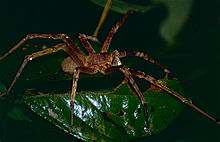Phoneutria fera
| Phoneutria fera | |
|---|---|

| |
| P. fera from French Guiana | |
| Scientific classification | |
| Kingdom: | Animalia |
| Phylum: | Arthropoda |
| Subphylum: | Chelicerata |
| Class: | Arachnida |
| Order: | Araneae |
| Infraorder: | Araneomorphae |
| Family: | Ctenidae |
| Genus: | Phoneutria |
| Species: | P. fera
|
| Binomial name | |
| Phoneutria fera | |
| Synonyms[1] | |
| |
Phoneutria fera is a species of spider with medically significant venom in the family Ctenidae found in South America (Colombia, Ecuador, Peru, Brazil, Suriname, and Guyana).[1] It is commonly known as the Brazilian wandering spider and the banana spider,[2] although these names are applied to other species in the genus Phoneutria, particularly Phoneutria nigriventer.[3][2] P. fera tends to spend a larger amount of time in vegetation during the early period of its life and spends more time on the ground once it becomes larger. This is more common in females, since they are usually larger than males.[4][5] Medical records from within the geographic range of P. fera show bites (likely from P. fera or its close relative P. reidyi), have the potential to develop moderate to severe systematic reactions in humans.[6]
References[]
- ^ a b c "Taxon details Phoneutria fera Perty, 1833", World Spider Catalog, Natural History Museum Bern, retrieved 2017-04-07
- ^ a b https://www.independent.co.uk/news/uk/home-news/brazilian-wandering-spider-deadly-allegedly-found-asda-bananas-a7321206.html RET. Nov. 06, 2017 03:05 CST
- ^ Wolfgang Bücherl; Eleanor E. Buckley (2013-09-24). Venomous Animals and Their Venoms: Venomous Invertebrates. Elsevier. pp. 237–. ISBN 978-1-4832-6289-5.
- ^ Gasnier, Thierry Ray; de Azevedo, Clarissa Salette; Torres-Sanchez, Martha Patricia & Höfer, Hubert (2002), "Adult size of eight hunting spider species in Central Amazonia: temporal variations and sexual dimorphisms", Journal of Arachnology, 30 (1): 146–154, doi:10.1636/0161-8202(2002)030[0146:ASOEHS]2.0.CO;2
- ^ Torres-Sanchez, Martha Patricia & Gasnier, Thierry Ray (2010), "Patterns of Abundance, Habitat Use and Body Size Structure of Phoneutria reidyi and P. fera (Araneae: Ctenidae) in a Central Amazonian Rainforest", Journal of Arachnology, 38 (3): 433–440, doi:10.1636/P08-93.1, S2CID 55763428
- ^ Sampaio, V.S.; Gomes, A.A.; Silva, I.M.; Sachett, J.; Ferreira, L.C.; Oliveira, S.; Sabidò, M.; Chalkidis, H.; Barbosa Guerra, M.G.; Salinas, J.L.; Wen, F.H.; Lacerda, M.V. & Monteiro, W.M. (2016), "Low Health System Performance, Indigenous Status and Antivenom Underdosage Correlate with Spider Envenoming Severity in the Remote Brazilian Amazon", PLOS ONE, 11 (5): e0156386, Bibcode:2016PLoSO..1156386S, doi:10.1371/journal.pone.0156386, PMC 4881914, PMID 27227455
| Wikimedia Commons has media related to Phoneutria fera. |
- Ctenidae
- Spiders of South America
- Spiders described in 1833
- Taxa named by Maximilian Perty
- Ctenidae stubs